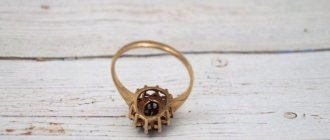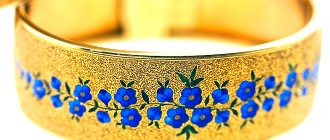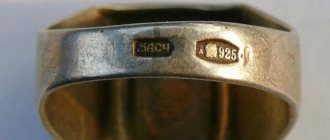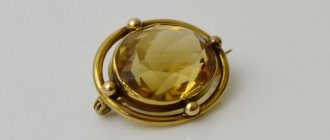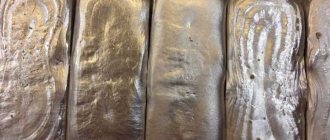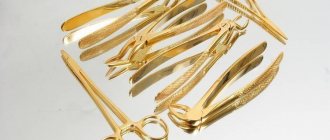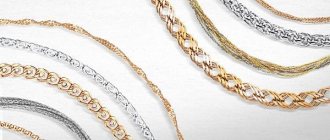Rare 900 standard silver and gold: composition, alloy properties and shade table
900 silver, like gold, is almost never used for jewelry purposes. These alloys themselves are quite ductile, are considered rare, and are used only for handmade work to order.
The density of 900 gold is 19.32 g/cm3. High-grade metal with a minimal amount of impurities is quickly scratched, chipped, deformed, loses its external shine and attractive appearance. The composition may have faint shades, which will vary depending on the proportion of each component of the alloy. The following color options are available:
| Metal color | Share of components, gr. | Share of components, gr. | Share of components, gr. |
| Gold | Silver | Copper | |
| Red | 900 | 10 | 90 |
| Yellow | 900 | 40 | 60 |
| White | 900 | 90 | 10 |
Applications of gold
In industry, the yellow precious metal is used to make ingots for the market system of states. Gold easily reflects sunlight and is polished. Tinted glass is made from yellow metal (used for skyscrapers). This significantly saves thermal energy. The precious metal also found use among astronauts. A small amount is added to a protective helmet to reflect the flow of infrared radiation in outer space.
It is often used in dental surgery for the manufacture of dental crowns and dentures, as it does not cause allergic reactions.
Gold is used to coat corrosive metals, manufacture household items, and in the electrical industry. The color of the metal and alloy changes under the influence of the substances that make up the alloy. Quantitative characteristics determine labeling and cost. 900 standard has 90 percent of only one gold. Metal melts at a temperature of 1063 degrees and boils at 2250 degrees.
Gold metal marked 900 is used in many countries around the world. In Russia, products made of precious metals with this designation are not officially stamped, but are marked with a 750 standard stamp.
In expensive, exquisite jewelry, 900 hallmark looks beautiful and prestigious. It is often bought up and sold abroad at a profit. Jewelry is stored for a long time and can be passed on to future offspring without financial investment.
In the 18th century in Russia, coins were minted with a similar alloy. Emperor Alexander III finally introduced the marking with the designation 900, which is still used today.
Jewelry 900 standard contains silver and copper. A rich yellow color is characteristic of products with a low copper content (1%). The bright yellow-red color of the alloy contains up to 9% copper.
In Russia, from 1798 until 1927, the spool marking was used for jewelry metal. The system was designed as follows: the sample was based on one pound containing 96 spools. For example, in 36 spools the mass of the precious metal was 0.375 of the weight of the alloy.
Use of 900 hallmark in precious metals
Despite its natural softness, 900 gold is used for the production of collectible coins and jewelry in certain countries of Asia and Europe. However, the shade of such items may differ, since different ligature ratios are used.
Jewelry items are massive in size and heavy in weight due to the increased softness of the alloy.
Dentistry
Until 1956, dentists used alloy 916. Afterwards, it was decided to use 900 sample, which was considered of higher quality. This composition was distinguished by greater strength and lower cost of prostheses. Metal is used to make crowns due to its hypoallergenic qualities.
900 gold tooth
Jewelry in Europe, China and the Far East
900 standard is partially equivalent to foreign quality standards, since it refers to 21.6 carats. This gold is sometimes used to make jewelry in Germany, China, India, Egypt, Thailand, and the UAE.
Making commemorative coins
During the times of Ancient Rus', high-grade gold was actively used to issue coins. Under Tsar Peter I, alloys from 781 to 980 could be used to make coins. Only under Queen Elizabeth, means of payment began to be made from precious metals mixed with 14% ligature.
900 fine coins
In Ancient Rus', high-grade expensive metal was used for minting coins. During the reign of Tsar Peter I, coins were made from aurum, marked from 781 to 980. During the reign of Queen Elizabeth, money was made from an alloy containing 14 grams of impurities.
Popular coins:
- 10 ruble coin: released in 1887, weight was 13 grams. At the moment, the coin is highly valued, the cost is $5,000.
- A coin with a face value of 10 rubles, issued in 1899: weight was 8.6 grams, it depicts a photo of Nicholas II.
Nicholas II restored the lost tradition of making portrait coins, starting with the coronation ruble. All metal money made of gold and silver of Nicholas II were with his image.
At the beginning of the 20th century, coins with a denomination of 5 rubles were issued in large quantities. So, in 1910, 200,018 coins were produced, and in 1911, 100,011.
Coins of that time had a characteristic red tint. The alloy contained 10% copper. These coins were called chervonets.
Noble metal 900 marking was used for minting Soviet chervonets. The people called this coin “the sower.” The mass of the metal product was 8.6 grams, the gold content without impurities was 7.74 grams.
In the 20th century, Prussian coins of 900 fineness were popular in Europe. They were minted from 1888 to 1918, the ruler of Prussia was Wilhelm II.
In Ukraine, a 200 hryvnia coin was issued in 1997. It depicted Taras Shevchenko. At the moment its cost is $2,000.
Where and how can you buy 900 gold
Today metal 900 is actively used for making souvenir coins. Thus, Sberbank offers a large selection of different coin symbols dedicated to different world dates and events. One of the most popular “Orthodox Saints” series, minted by the Polish Mint. Each such symbol weighs 8 grams and contains images of saints. You can buy them at any branch of a financial institution.
Also, 900 standard can be found in pawn shops or other institutions that accept precious scrap and jewelry. Here this precious brand is represented by imported products, the price is much lower than ordering from jewelers.
Gold jewelry from a pawnshop
Sample system
There is no single system by which a sample is determined. In Russia and the CIS countries it is one, in the USA it is another. Let's take a closer look at the basic units of measurement.
Metric system
The classification was introduced in the Soviet Union. It indicates how many grams of pure gold the product contains. This system is still used today.
According to classification, 6 samples are produced:
- 375 standard – 37.5% metal – bright yellow decoration;
- 500 sample – 50%;
- 585 sample – 58.5%;
- 750 sample – 75%;
- 900 sample – 90%;
- 999 sample – 99.9.
Jewelers consider the 750 standard to be the most successful, since it contains the optimal ratio of silver, nickel and gold during manufacturing, which makes the alloy durable and elastic. The sample is especially highly valued by smelters, but it is not often released due to its high price. Jewelry made from it does not fade or wear off.
The most popular standard is 585. Almost all women's gold rings with diamonds and other precious stones are made with it.
Carat system
Found in the USA and some European countries. The carat is the official unit of measurement for gemstones. It is equal to 0.2 g. However, the sample itself is calculated differently. The product is conventionally divided into 24 shares and indicates how many parts are pure metal. For example, 23k purity means that the jewelry is divided into 24 parts, and 23 is the composition of pure gold.
Unlike the metric system, there are more measurements in the carat classification: there are 10 of them. Thus, the 375 standard corresponds to 9 carats, and the 750 standard corresponds to 18.
When choosing jewelry, look carefully at the details. It is easy to find out the gold purity number. On earrings it is placed on a hook or pin, the inner or outer side of the hook is marked in rings, and on bracelets the stamp can be found near the clasp or on the link that connects the lock to the main part.
The cost of 1 gram is 900 standard. Pricing factors from exchange to purchase
The basis for the cost of a precious metal with any composition is the price per gram established by the Central Bank of Russia. Further, the cost of gold products is influenced by the cost of the alloy used, the work of the jeweler, the complexity of the order, transportation and other costs, and the seller’s markup.
| The price of 1 gram of metal is 999 in the Central Bank of Russia | 4360 rub. |
| Market value of 1 gram of 900 sample | 3904 rub. |
| Scrap price 900 | 3513 rub. |
| 900 gold standard price for 1 gram of jewelry in retail stores | 8100 rub. |
Pros and cons of 900 gold
900 grade has certain advantages and disadvantages due to the natural properties of the metal.
Pros:
does not oxidize, does not change color upon contact with skin;
hypoallergenic alloy, not capable of provoking allergic reactions in the body;
natural shade of products;
Suitable for investment due to high pure gold content;
products may have different shades.
Minuses:
an officially non-existent jewelry brand for which a quality certificate is not issued;
used only by jewelers to make custom items;
Over time, it loses its shine and the protective layer wears off;
easily deformed, scratched, chipped;
high cost of metal;
not suitable for daily use.
Sample and composition of jewelry
The percentage of pure metal in an alloy is the fineness. Each product is stamped with a corresponding number. Any metal that contains more than one component has a hallmark. It indicates the alloying element in relation to the precious metal.
This term is more often used in jewelry. In all gold jewelry, another metal is added to give the product certain properties, such as the desired color or hardness, since gold itself is soft.
This additive is called a ligature. The following components are used as additional components to gold:
- nickel – improves fluidity during melting;
- zinc – changes the melting point;
- silver – gives a different shade;
- copper – increases strength;
- palladium – adds whiteness.
Thus, jewelry collections feature items made from different shades of gold. White gold is considered the ideal setting for diamonds. The alloy contains only white metals: silver, platinum or nickel.
Wedding rings made of white gold and platinum are the most expensive, but they retain their attractive appearance for a long time and do not cause allergies.
The reddish shade of gold is obtained by adding copper, and the yellowish shade is obtained by adding silver.
Tips for caring for soft gold
Since 900 grade is almost pure metal, there are some rules for care:
- Jewelry should not be used for daily wear. It is best to wear them on a special occasion. Otherwise, they will quickly lose their attractive appearance.
- It is not recommended to wear jewelry in the bathhouse, swimming pool, gym or while working around the house.
- For storage, it is important to get a bag or box. Each product must be stored separately to prevent damage and deformation.
- It is important to limit contact of products with cosmetics and chemicals.
- To clean minor contaminants from the alloy, you can use a mild soap solution and a soft cloth. It is better to entrust polishing and more thorough cleaning to specialists.
Reviews
I knew that gold is used in many areas, but I was surprised that 900 gold is used for tinting. It turned out that the metal transmits light well and does not lose heat. I was convinced when I saw how gold plating was used in the construction of skyscrapers.
Artem L. g, Ivanovo
Valeria P. g, Stavropol
I received as a gift a silver bracelet with gold inserts, made in Poland, 900 karat. I thought it was a fake until the specialist explained that it is actively used abroad for jewelry. I think the main disadvantage is the softness. Minimal pressure leaves dents on the decoration elements. In addition, the metal quickly loses its shine and darkens.
We made a custom-made chain of 900 gold. The master immediately warned us that according to GOST such a sample does not exist. The decoration turned out to be massive and full-bodied. But not for everyday wear, as scratches quickly appear on the surface.
Valentina P., Donetsk
Foreign 900 gold
Many countries, such as China, Tunisia, and the UAE, use the carat value of the precious metal, which is equal to 21.6 carats. In carat equivalent, 900 fineness is inferior to foreign gold of 22 carats. This measure corresponds to a noble metal of 916 units.
900 standard gold is used in European countries. Jewelry made from gold of this standard is made to order in India, China, the UAE, Egypt and Thailand.
In England and Spain, in addition to the carat, there was a submultiple unit of 1/4 carat, equal to 1 spool. A unit of 1/16 carat was also used.
